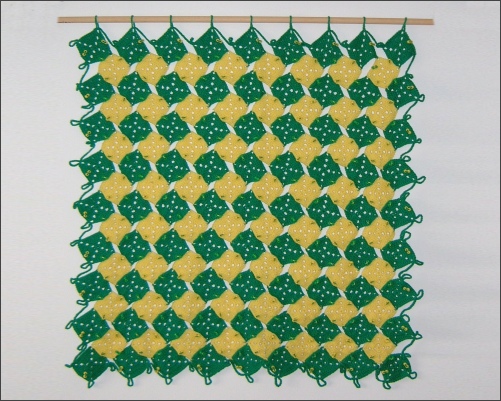




The faithful Curious and Interesting Geometry next revealed another possibility that
sent us in several directions at once. ‘Hinged tessellations’ are shapes that will
fit together to cover the surface but they are only joined at some of their corners
so they can swing apart to make interesting patterns of shapes and holes. We were
only interested in the squares. Pairs of squares are hinged alternately at top or
bottom so that the whole pattern can be pulled apart to leave rhombus-
We had grand plans to make an artwork that would move through the various stages simply by pulling a cord. We scoured haberdashery, gardening and DIY shops to find suitable mechanisms. The squares were easy. They were clear plastic with sparkly hologram foil on one side. They had holes in the corners and split rings, normally used for jewellery, in the corners to join them together. The whole assembly was attached to a pole with cords passing through at strategic points. It worked in theory but we were never happy with the practical operation and it was eventually abandoned.
However this proved to be another opening onto a new path and ‘things that move’
took over our thoughts. It wasn’t possible to recreate the movement of hinged squares,
in yarn. We could cope with the fully open or fully closed positions and, by adding
beads to every square we could make the same hanging do both of these, but nothing
in between. The hanging has 64 squares in one colour and 81 in another colour and
we were quite surprised to realise that we needed to use two square numbers to make
the larger square pattern. As with many of he afghans, this is immediately obvious
when you look at the finished piece. The beads act as buttons, the squares have holes
that act as buttonholes. In the opened-
